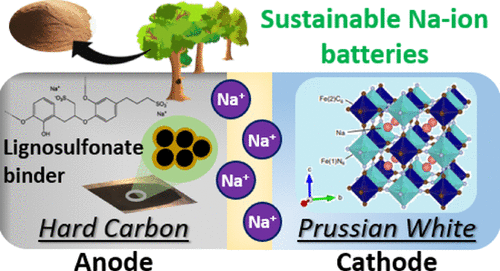当前位置:
X-MOL 学术
›
ACS Sustain. Chem. Eng.
›
论文详情
Our official English website, www.x-mol.net, welcomes your
feedback! (Note: you will need to create a separate account there.)
A Lignosulfonate Binder for Hard Carbon Anodes in Sodium-Ion Batteries: A Comparative Study
ACS Sustainable Chemistry & Engineering ( IF 7.1 ) Pub Date : 2021-09-02 , DOI: 10.1021/acssuschemeng.1c05263 Ritambhara Gond 1 , Habtom Desta Asfaw 1 , Omid Hosseinaei 2 , Kristina Edström 1 , Reza Younesi 1 , Andrew J. Naylor 1
ACS Sustainable Chemistry & Engineering ( IF 7.1 ) Pub Date : 2021-09-02 , DOI: 10.1021/acssuschemeng.1c05263 Ritambhara Gond 1 , Habtom Desta Asfaw 1 , Omid Hosseinaei 2 , Kristina Edström 1 , Reza Younesi 1 , Andrew J. Naylor 1
Affiliation

|
An important factor in the development of sodium-ion batteries (SIBs) is the use of cheap and sustainable materials. Sodium lignosulfonate, a lignin derivative, is demonstrated here as an attractive, “green”, water-soluble, and potentially cost-effective binder for use in hard carbon anodes for SIBs. A comparison of its battery cycling performance is made against other binders including sodium carboxymethyl cellulose and lignin, obtained from the kraft process, as well as sodium alginate, derived from algae. Apart from lignin, which requires processing in N-methyl-2-pyrrolidone, the other three binders are water-soluble. Lignosulfonate shows comparable or better performance, with high capacity retention and stability, when using 1 M NaPF6 in propylene carbonate or ethylene carbonate:diethyl carbonate electrolytes for both half- and full-cells (against a Prussian white cathode). Further improvements are observed when including styrene-butadiene rubber as a co-binder. X-ray photoelectron spectroscopy demonstrates similar solid electrolyte interphase compositions after the initial sodium insertion for both lignosulfonate and carboxymethyl cellulose binders. However, after subsequent cycling, the surface layer composition and thickness are found to be dependent on the binder. For the lignosulfonate-based electrode, the layer appears thicker but comprises a smaller fraction of carbon–oxygen species.
中文翻译:

用于钠离子电池硬碳阳极的木质素磺酸盐粘合剂:比较研究
钠离子电池 (SIB) 发展的一个重要因素是使用廉价且可持续的材料。木质素磺酸钠是一种木质素衍生物,在本文中被证明是一种有吸引力的“绿色”、水溶性且具有潜在成本效益的粘合剂,可用于 SIB 的硬碳阳极。将其电池循环性能与其他粘合剂进行了比较,包括从牛皮纸工艺获得的羧甲基纤维素钠和木质素,以及从藻类中提取的海藻酸钠。除了木质素需要在N-甲基-2-吡咯烷酮中处理外,其他三种粘合剂都是水溶性的。当使用 1 M NaPF 6时,木质素磺酸盐表现出相当或更好的性能,具有高容量保持率和稳定性在碳酸亚丙酯或碳酸亚乙酯中:用于半电池和全电池的碳酸二乙酯电解质(针对普鲁士白阴极)。当包含苯乙烯-丁二烯橡胶作为辅助粘合剂时,可以观察到进一步的改进。X 射线光电子能谱表明,木质素磺酸盐和羧甲基纤维素粘合剂在初始钠插入后具有相似的固体电解质界面组成。然而,在随后的循环之后,发现表面层组成和厚度取决于粘合剂。对于基于木质素磺酸盐的电极,该层看起来更厚,但包含较小比例的碳氧物质。
更新日期:2021-09-20
中文翻译:

用于钠离子电池硬碳阳极的木质素磺酸盐粘合剂:比较研究
钠离子电池 (SIB) 发展的一个重要因素是使用廉价且可持续的材料。木质素磺酸钠是一种木质素衍生物,在本文中被证明是一种有吸引力的“绿色”、水溶性且具有潜在成本效益的粘合剂,可用于 SIB 的硬碳阳极。将其电池循环性能与其他粘合剂进行了比较,包括从牛皮纸工艺获得的羧甲基纤维素钠和木质素,以及从藻类中提取的海藻酸钠。除了木质素需要在N-甲基-2-吡咯烷酮中处理外,其他三种粘合剂都是水溶性的。当使用 1 M NaPF 6时,木质素磺酸盐表现出相当或更好的性能,具有高容量保持率和稳定性在碳酸亚丙酯或碳酸亚乙酯中:用于半电池和全电池的碳酸二乙酯电解质(针对普鲁士白阴极)。当包含苯乙烯-丁二烯橡胶作为辅助粘合剂时,可以观察到进一步的改进。X 射线光电子能谱表明,木质素磺酸盐和羧甲基纤维素粘合剂在初始钠插入后具有相似的固体电解质界面组成。然而,在随后的循环之后,发现表面层组成和厚度取决于粘合剂。对于基于木质素磺酸盐的电极,该层看起来更厚,但包含较小比例的碳氧物质。










































 京公网安备 11010802027423号
京公网安备 11010802027423号